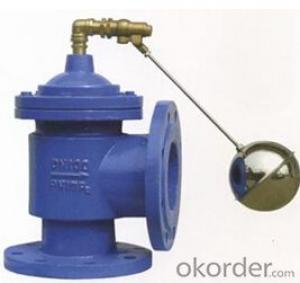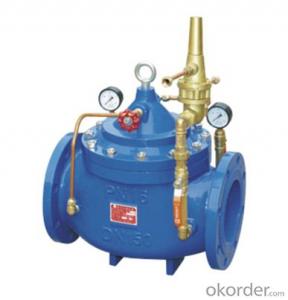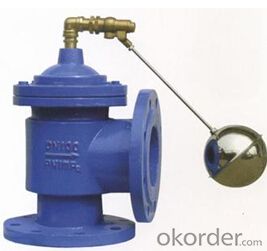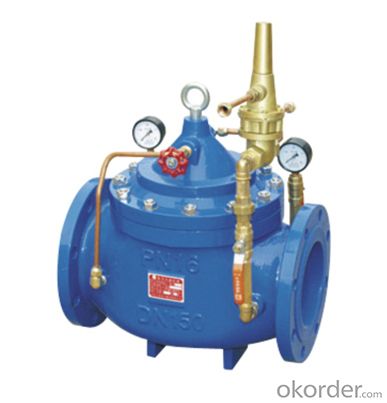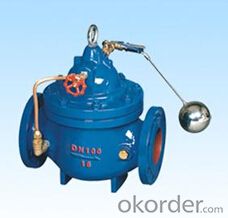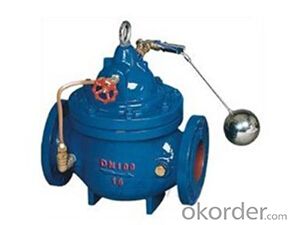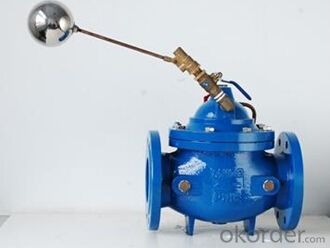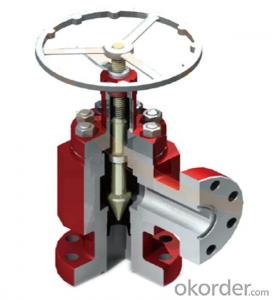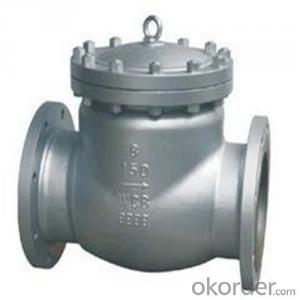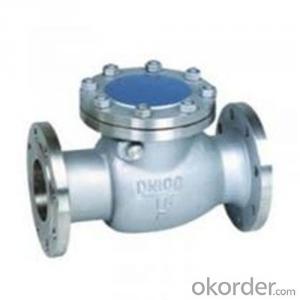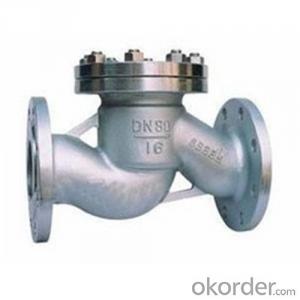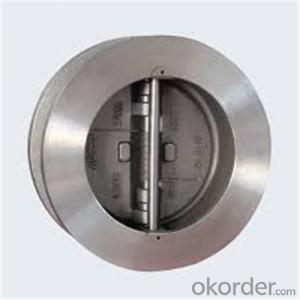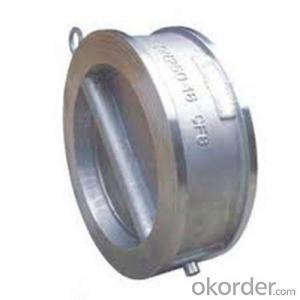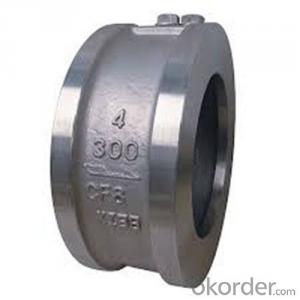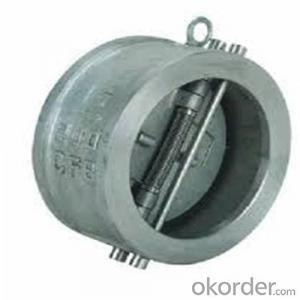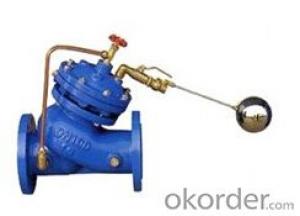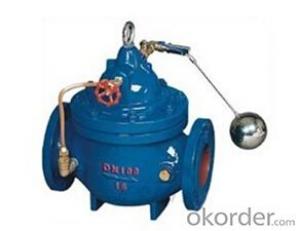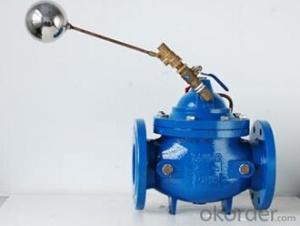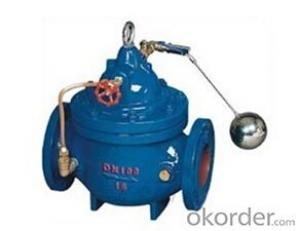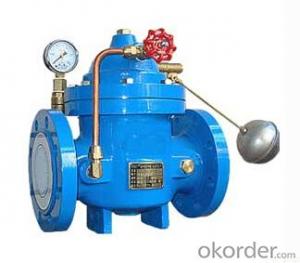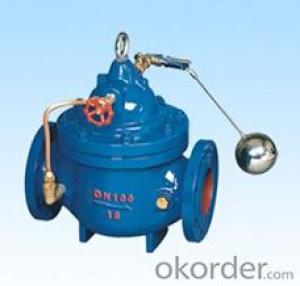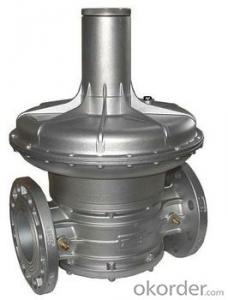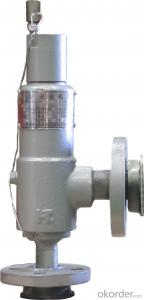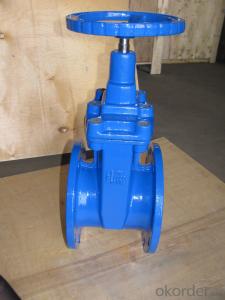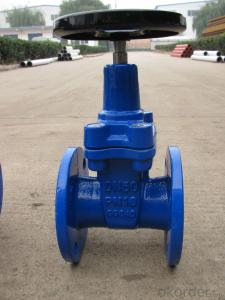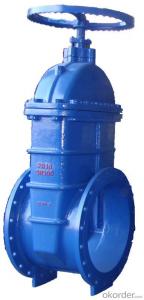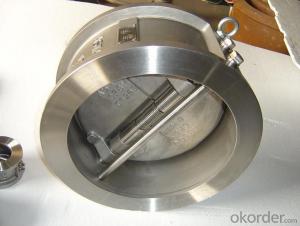DN400 Ductile Iron Remote control float valve
- Loading Port:
- Tianjin
- Payment Terms:
- TT OR LC
- Min Order Qty:
- 1 set
- Supply Capability:
- 5000 set/month
OKorder Service Pledge
OKorder Financial Service
You Might Also Like


General valve using the market long-term, widespread Water Leakage, rust phenomenon, soft sealing gate valve produced by the introduction of foreign advanced technology of the enterprise. To overcome the poor sealing gate valve, general elastic fatigue, rust and other defects. Soft sealing gate valve is a traditional valve replacement products, the compensation effect of using flexible gate produce small deformation, achieve good sealing effect, the valve has a light switch, reliable sealing, good elastic memory and long service life and other significant advantages, can be widely used in water, sewage, construction, food, medicine, metallurgy, electric power, textile, energy systems, fluid pipeline regulation and closure devices as.
The characteristics of:
- flat style seat
The traditional control valve often pass after washing due to foreign objects such as stone, wood, cement, paper, and other debris deposited on the valve at the end of the groove. Close but not close easily lead to the formation of Water Leakage phenomenon, the lower part of the soft sealing gate valve with water using the same flat design, easy to siltation caused by debris, the fluid unimpeded.
And the overall package glue
The valve plate is made of high-quality rubber overall, the outsourcing of plastic, making the domestic first-class rubber vulcanization vulcanization after the valve plate to ensure accurate geometry, and the rubber and ductile iron gate is connected firmly, not easy to fall off and good elastic memory.
And corrosion resistance
The valve body adopts epoxy coating powder, can prevent the corrosion and rust, and can be used for sewage systems.
And not easy to break
Traditional cast iron garden gate often hit foreign objects, collision or overlap caused by the fracture phenomenon. Because the valve to switch to ductile iron, this is the case already significantly reduced.
Three "O" ring seal
As the valve stem with three "0" ring ring seal design, can reduce friction when the switch is greatly reduced, Water Leakage phenomenon and can cut off the water supply construction not replace sealing ring.
And help to drink
Due to the internal body to non-toxic epoxy resin coating, gate of the inner and outer surfaces are completely coated with rubber and can not rust or corrosion of water available to drink.
- Casting valve
Valve body casting, precise geometry makes the body without any internal finishing to ensure that the valve seal.
And light weight
The valve is made of ductile cast, lighter in weight than conventional gate weight about 20%-30%. Convenient installation and repair.
Overview:
General valve using the market long-term, widespread Water Leakage, rust phenomenon, soft sealing gate valve produced by the introduction of foreign advanced technology of the enterprise. To overcome the poor sealing gate valve, general elastic fatigue, rust and other defects. Soft sealing gate valve is a traditional valve replacement products, the compensation effect of using flexible gate produce small deformation, achieve good sealing effect, the valve has a light switch, reliable sealing, good elastic memory and long service life and other significant advantages, can be widely used in water, sewage, construction, food, medicine, metallurgy, electric power, textile, energy systems, fluid pipeline regulation and closure devices as.
The characteristics of:
- flat style seat
The traditional control valve often pass after washing due to foreign objects such as stone, wood, cement, paper, and other debris deposited on the valve at the end of the groove. Close but not close easily lead to the formation of Water Leakage phenomenon, the lower part of the soft sealing gate valve with water using the same flat design, easy to siltation caused by debris, the fluid unimpeded.
And the overall package glue
The valve plate is made of high-quality rubber overall, the outsourcing of plastic, making the domestic first-class rubber vulcanization vulcanization after the valve plate to ensure accurate geometry, and the rubber and ductile iron gate is connected firmly, not easy to fall off and good elastic memory.
And corrosion resistance
The valve body adopts epoxy coating powder, can prevent the corrosion and rust, and can be used for sewage systems.
And not easy to break
Traditional cast iron garden gate often hit foreign objects, collision or overlap caused by the fracture phenomenon. Because the valve to switch to ductile iron, this is the case already significantly reduced.
Three "O" ring seal
As the valve stem with three "0" ring ring seal design, can reduce friction when the switch is greatly reduced, Water Leakage phenomenon and can cut off the water supply construction not replace sealing ring.
And help to drink
Due to the internal body to non-toxic epoxy resin coating, gate of the inner and outer surfaces are completely coated with rubber and can not rust or corrosion of water available to drink.
- Casting valve
Valve body casting, precise geometry makes the body without any internal finishing to ensure that the valve seal.
And light weight
The valve is made of ductile cast, lighter in weight than conventional gate weight about 20%-30%. Convenient installation and repair.


- Q: what would happen if valve was not adjusted right? and please explain
- Valves let in fuel/air mixture on the intake stroke, hold the combustion chamber under pressure on the compression and power strokes, and let exhaust out in the exhaust stroke of the engine. As you might guess, intake valves control the intake and exhaust valves control the exhaust. If valves are not adjusted right they usually get noisy because the tappets have some distance to move before they press down on the valves. It is much worse if the valves are adjusted too tight - they don't close all the way and hot exhaust gases burn them. It is also possible for the whole valve train to be out of time, which reduces power and fuel economy.
- Q: my check engine light just came on and i have some oil on the block of my engine, a friend told me that the valve cover gasket needs resealed. could that be why my check engine light is on?
- Most likely if you see oil on the block you need to re-do the head gasket which sucks but the valve cover gasket is usually not the reason for most leaks, could be at least i would start there most new cars have a rubber gasket which can be re-used if you have to open the cover. But yeah this can turn the light on depending on what car you have but for sure. Replace the valve cover gasket and see what happens, they are usually like $30.00 bucks or less.
- Q: Im replacing the valve stem seals and i dont know how to remove the springs and with the valve compressor wont fit in the engine
- you will need to remove the plugs, get a air compressor with a hose that will screw into the spark plug hole ! then you pump the compressor up to about 40 or 50 pounds, take the rockers off and pull the push rods ! you will need a spring compressor to squeeze the valve spring and take a pair of need nose pliers and take the keepers out and then the spring will lift off the valve stem ! after the spring is off you can remove the valve seal ! i recommend for you to use the umbrella type seals !
- Q: What is the function of valves between atrium and ventricle in the heart?thanks
- the atrioventricular valves (AV valves) separates the atria from the ventricles. the AV valves perform a very important function in the heart by maintaining the blood flow in one direction. they are subjected to tremendous strain during every heart beat, and are uniquely designed to withstand this strain through a person’s lifetime. the right AV valves is called the tricuspid valve. the left AV valve is called the mitral valve. the opening and closing of the AV valves is dependent on pressure differences between the atria and ventricles. when the ventricles relax, atrial pressure exceeds ventricular pressure, the AV valves are pushed open and blood flows into the ventricles. however, when the ventricles contract, ventricular pressure exceeds atrial pressure causing the AV valves to snap shut. :)
- Q: Compare and contrast stenosis and regurgitation (insufficiency) in terms of the functional abnormality associated with the valve leaflets and their effects on hemodynamic parameters such as stroke volume.
- stenosis okorder /
- Q: My car hesitates on the highway 55 m/h and up after about 20 minutes of highway driving, I unplugged the EGR valve to see if it still hesitates, but the problem went away after disconnected the Egr, so is it for sure that the valve is bad? Just wanted to make sure there's no other component that could be also be bad. I have a toyota avalon 1997.
- This does not sound like an EGR valve problem. As stated previously, failed EGR valve symptoms tend to occur at an idle. Your problem may be in the passages that feed the inert EGR gasses to the engine. On many engines, there are multiple passages feeding the engine. One for each cylinder. Since EGR flow consists of burned fuel and oxygen, it is an inert gas. Not capable of supporting combustion because there is no oxygen or fuel left in it. It simply takes up space and is used to cool your exhaust output for emissions reduction. If several of these passages plug up, then the remaining cylinders are fed too much of this inert gas and it affects combustion in those cylinders. Normally during highway cruising this inert gas can be fed to all cylinders equally without a noticeable effect on performance. This scenario is possible on any engine that uses EGR ports in the heads or intake manifold to feed individual cylinders. Removing the EGR flow removes the imbalance and your symptom goes away. Barring that, it is still unlikely that the valve is the cause of your symptom. EGR flow at the wrong time such as during acceleration but not at idle can be caused by the vac controls. Hope this helps!
- Q: I have 1998 Husqvarna WR250 2-stroke and the torque valve isnt connected and i am wondering if its worth it4 me to track down the part that ismissing to get it working. does the torque valve increase power much? please help cos im wondering whether i should sell bike and get motocross bike instead.
- The torque valve (it's called the power valve, by most manufacturers) changes the exhaust port timing, depending on the RPMs of the engine. The valve blocks part of the top of the exhaust port. As the engine RPMs increase, the valve lifts up. The distance between the top of the exhaust port's opening and the top of the cylinder is changed. When the piston is moving down on it's power stroke, the opening of the exhaust port is exposed sooner (due to the valve lifting up) and the ignited fuel exits the cylinder faster. This process of changing the exhaust port's timing, creates more explosive power for the engine. So of course if it was hooked up, the engine's performance would increase.
- Q: I think the piece leaking is a valve;it is one solid piece of copper with two tubes, one which is a half inch that connectsinto the incoming hot water and then a small outgoing one that connects to the faucet and I don't know how to find a replacement part .. I think it is a Delta but I am not sure ... the house is 10 years old but where can I just find a valve instead of replacing the entire faucet if I don't know what the make or model is ?Any websites with pics of replacement valves for Roman Tubs??
- Remove the valve and take it to a plumbing supply store. Home Depot and the like may have what you're looking for; but you're more likely to find it at a plumber's supply. They are the only ones I've ever found who carry odd bits.
- Q: P.S.V. Pressure Safety Valve
- psv is a pressure sensitive valve the other is sspring loaded and will fail in time
- Q: I see a valve that says FNW on it with ( on, off ) but I'm not sure it's the main valve to the water supply. It does go to the water heater so I'm guessing that it's it. Does anyone know anything about the main water supply valve and how to find it?
- My water hose has a valve at the base of it close to the wall, if you need to shut off the main supply to the house it is usually located in the front yard close to the street. Mine have always been enclosed in a Cement type box that is in-ground with a lid that is flush with the ground.
Send your message to us
DN400 Ductile Iron Remote control float valve
- Loading Port:
- Tianjin
- Payment Terms:
- TT OR LC
- Min Order Qty:
- 1 set
- Supply Capability:
- 5000 set/month
OKorder Service Pledge
OKorder Financial Service
Similar products
Hot products
Hot Searches
Related keywords
